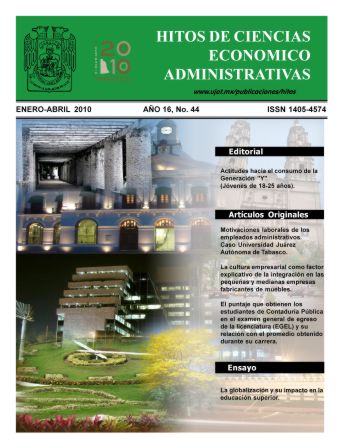ESTUDIO DE CASO: USO DE LAS REDES SOCIALES COMO UNA HERRAMIENTA DE ANÁLISIS DE LA ESTRUCTURA DE GRUPO INFORMAL.
DOI:
https://doi.org/10.19136/hitos.a0n44.501Keywords:
Redes sociales. Grupo. Estructura de grupo. Liderazgo.Abstract
RESUMEN Objetivo: Determinar el mapa y medir las relaciones y los contactos entre las personas en el mismo grupo o departamento de la organización. Material y método: Este estudio utilizó el análisis de redes sociales como técnica. El análisis de redes sociales, puede aplicarse para el desarrollo del mapa de relaciones. La medición del intervalo suele usarse en el análisis de redes sociales, para determinar la fuerza de la relación entre individuos o departamentos en la organización. Resultados: Después del análisis contrario a lo que se esperaba, se encontró que es muy baja la fuerza de relación entre el supervisor y su grupo de trabajo. Conclusiones: la organización tiene una estructura de grupo débil, ya que presenta porcentajes muy bajos de cohesión grupal. ABSTRACT Objective: Determine the map and measure the relationships and work flow between people in the same group or department of the firm. Material and method: This study used the social network analysis as a technique. The social network analysis can be applied to the development of map relationships. The measurement of the interval is occasionally used in the social network analysis to determine the strength of the relationship between the individuals or departments within the firm. Results: After the analysis, contrary to what was expected, it was found that the strength of the relationship between the supervisor and his work group is very low. Conclusions: The organization has a weak group structure, and shows very low percentages of group cohesion.Downloads
Downloads
Published
Issue
Section
License
As a requirement for the manuscript, the author is requested to provide the Copyright Assignment Letter, so that the Journal has the publication rights and to avoid plagiarism.
PLAGIARISM POLICIES
The Editorial Board of the Journal HITOS DE CIENCIAS ECONÓMICO ADMINISTRAIVAS has the authority to reject in the review process any manuscript that does not have adequate citation in the documents consulted in its scientific research work, which can be considered as plagiarism behaviors. Likewise, the referees carry out the plagiarism review using specialized software, such as iThenticate, among others.
COPYRIGHT POLICIES
Authors who have publications in the journal accept the following terms: • At the time the manuscript is accepted, the author transfers the copyright to the Journal HITOS DE CIENCIAS ECONÓMICO ADMINISTRATIVAS.
- The authors may make additional agreements for non-exclusive distribution of the published version of the article (e.g., including it in an institutional repository or publishing it in a book) provided that the initial publication in this journal is indicated.
- Authors are allowed and recommended to publish their research work on the Internet (eg, institutional or personal files), which would allow more beneficial exchanges to increase the citation of the published work.
This work is licensed under Creative Commons Attribution-NonCommercial-NoDerivatives 4.0 International





